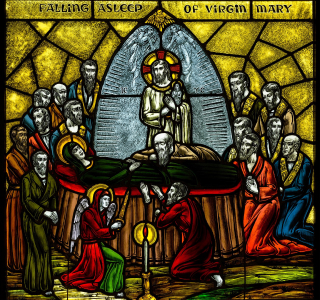Our history
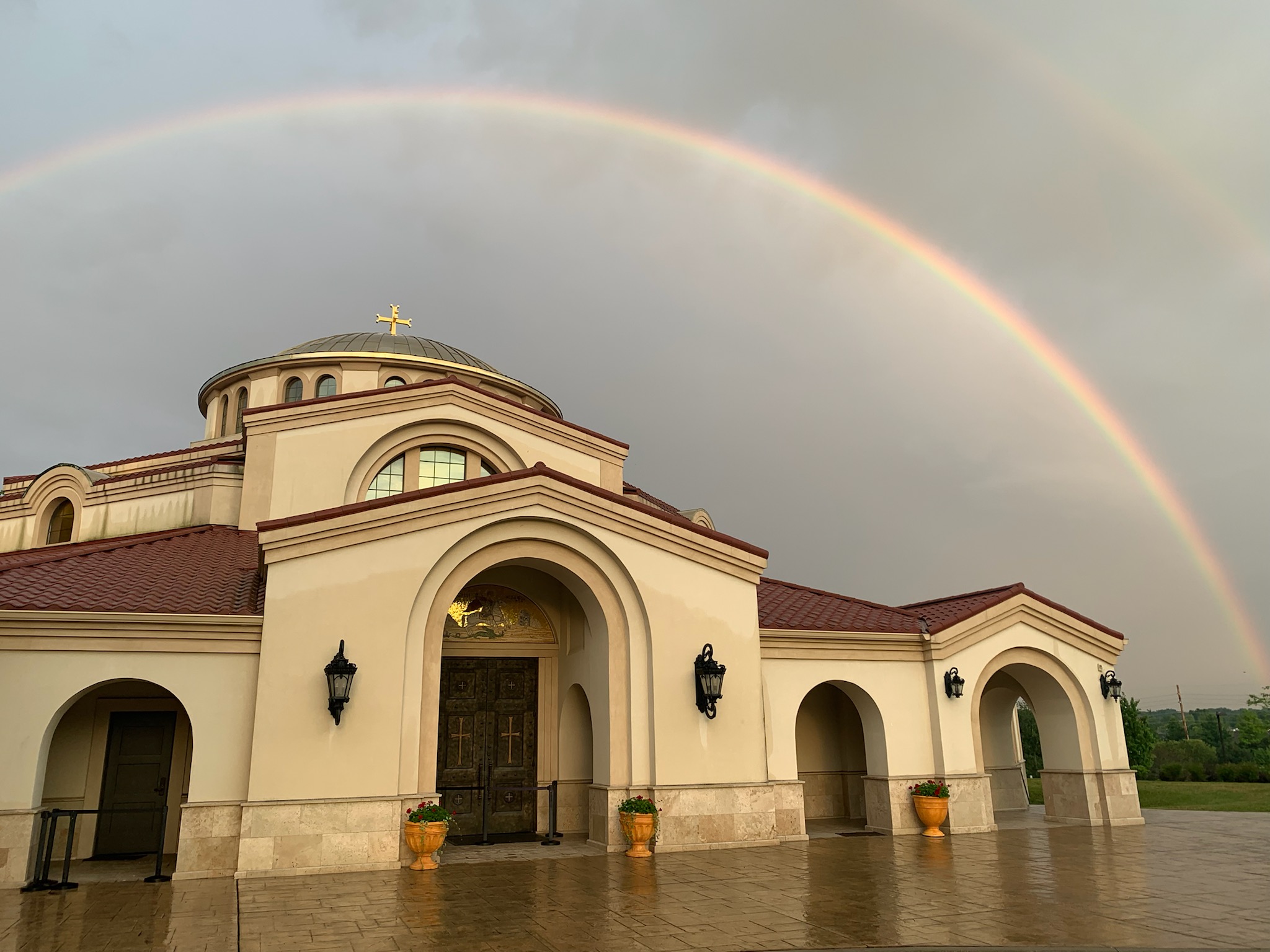
The history of this parish had its beginning in the hearts and minds of our founders who immigrated to America around the turn of the 20th century.
The first known Arabic-speaking Orthodox Christians to locate in central Indiana were Saada Nijm Kfouri of Talia and her husband, David Sliman Freije of Zahle, Lebanon, who settled in Indianapolis with their children in 1890. They operated a dry-goods store close to downtown. They and those who followed came to escape economic privation and persecution of Christians in the Middle East. They quickly became a vital part of Hoosier society. Many of them owned and operated grocery stores through the 1950s, before the advent of today’s supermarkets. They contributed in many ways and in many fields to the strength and richness of this country: public servants, physicians, scholars, scientists, artists, athletes and entertainers. They were all greatly devoted to their families and to family values. Many served their new homeland of America in the World Wars and subsequent conflicts. Most importantly they brought their Faith with them from the birthplace of Christianity. Today, moreover, St. George Orthodox Church has grown in size and diversity, serving those immigrants’ descendants and people of all ethnic and racial backgrounds. Finding no church to call their own, these early immigrants accepted invitations to use other churches until they could build their own, and services were sometimes held in the home of an Orthodox family whenever a missionary Orthodox priest came to town. Baptisms and weddings were often scheduled on these occasional visits.
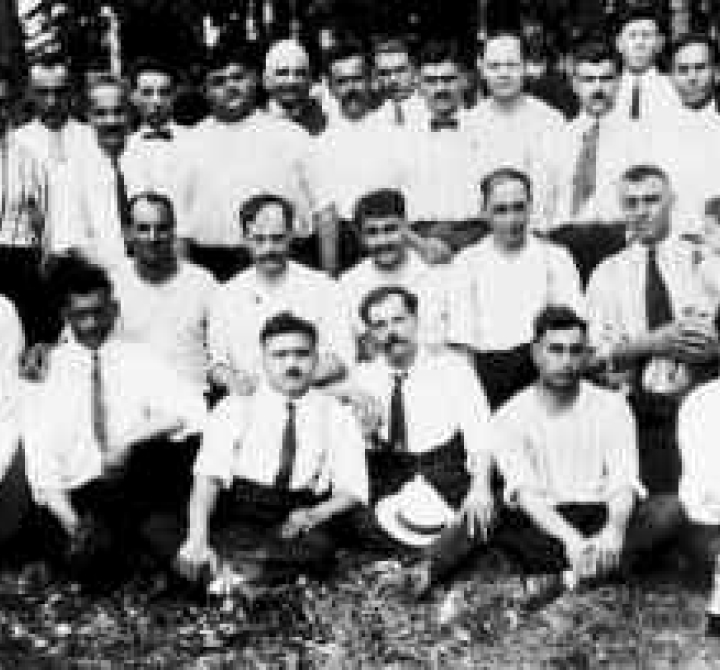
Later a Syrian-American Social Club was established in Indianapolis, and, in 1919, they purchased a building on North Davidson Street. This served as a social center for the Syrian community, and, when the missionary priest came to town, the Orthodox faithful would attend services held in the club room. The Reverend Antonius Bohlin from Michigan City, Indiana, was one of the first to visit Indianapolis on a regular basis. While the Orthodox faithful were grateful for these occasional visits by a priest, they knew that some day they must build a church and establish a permanent parish in the community. A small group of families that had come from Saidnaya, Syria, to settle in Elwood, Indiana, would make frequent visits to Indianapolis to attend these occasional services. The members of this group, the Mesalam, Corey and Couzma families, began meeting with the members of the Saliba, Freije, Hider, Matouk, Mitrey and other Indianapolis families as early as 1924 to discuss plans for building a church. Archbishop Germanos (Shahadi) on his pastoral visits encouraged this group to organize. His presence and beautiful voice were an inspiration to these zealous Orthodox families.
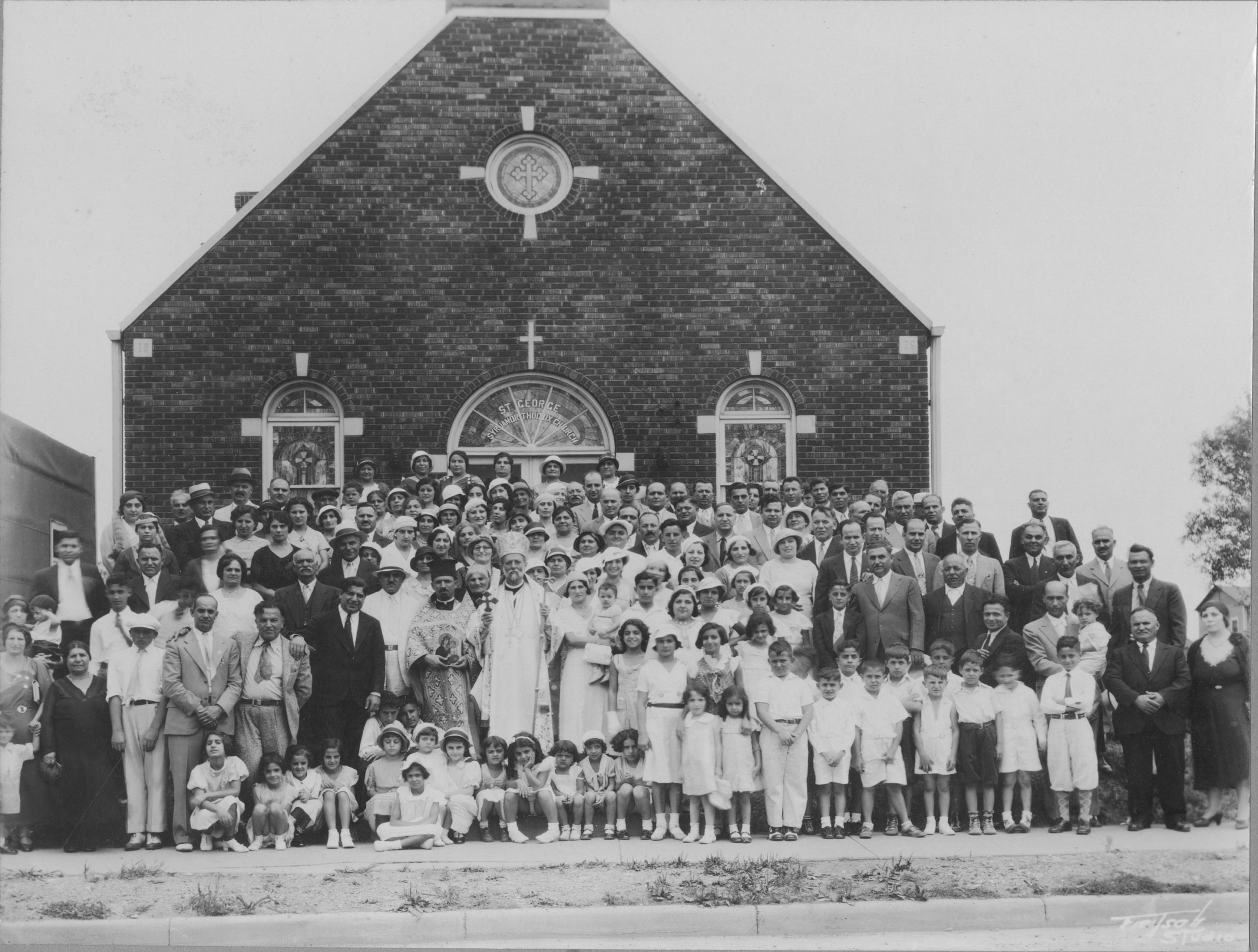
On February 8, 1925, a newly organized Knights of St. George filed Articles of Association with the Secretary of State of Indiana. The main purpose of the new group was to build a Syrian Orthodox church to serve the Indianapolis community. The first officers under the charter were Salim K. Freije, President; John Hider, Vice President; A.G. Corey, Secretary; and Abraham Joseph, Treasurer. As new interest was generated, a firm establishment of the new parish was aided by the Kurker, Risk, Eid, Albert and Kafoure families as well as many other individuals.On January 6, 1926, the young and energetic Archimandrite Antony Bashir met with the Knights of St. George, and, in that same year, the St. George Orthodox Church was erected and consecrated at 2745 North Sherman Drive. For many years this small brick edifice served the newly established parish’s spiritual needs. The parishioners, however, still felt a need for a fellowship hall.It was obvious that the church could not exist without the loving and working hands of her ladies. So it was that on March 20, 1932, the newly organized St. George Ladies’ Aid Society elected its first officers. Mrs. Salim (Katherine) Freije served as president of this new group. From its inception, the Ladies’ Aid has played a prominent role in the life of the parish, contributing thousands of hours of hard labor, self-sacrifice and financial assistance anywhere they were needed. They continue to prepare for mercy meals and many other occasions, and they strive to instill the Orthodox Faith in our youth, with particular concern to see that young girls today find a meaningful role in the life of their Church.After many years of planning and saving during the lean depression years, the parish embarked on building a social hall on ground adjacent to the church. Several church members and the parish priest, Reverend John Corey, actually took shovels, saws and hammers in hand to help in building the Knights of St. George Hall.
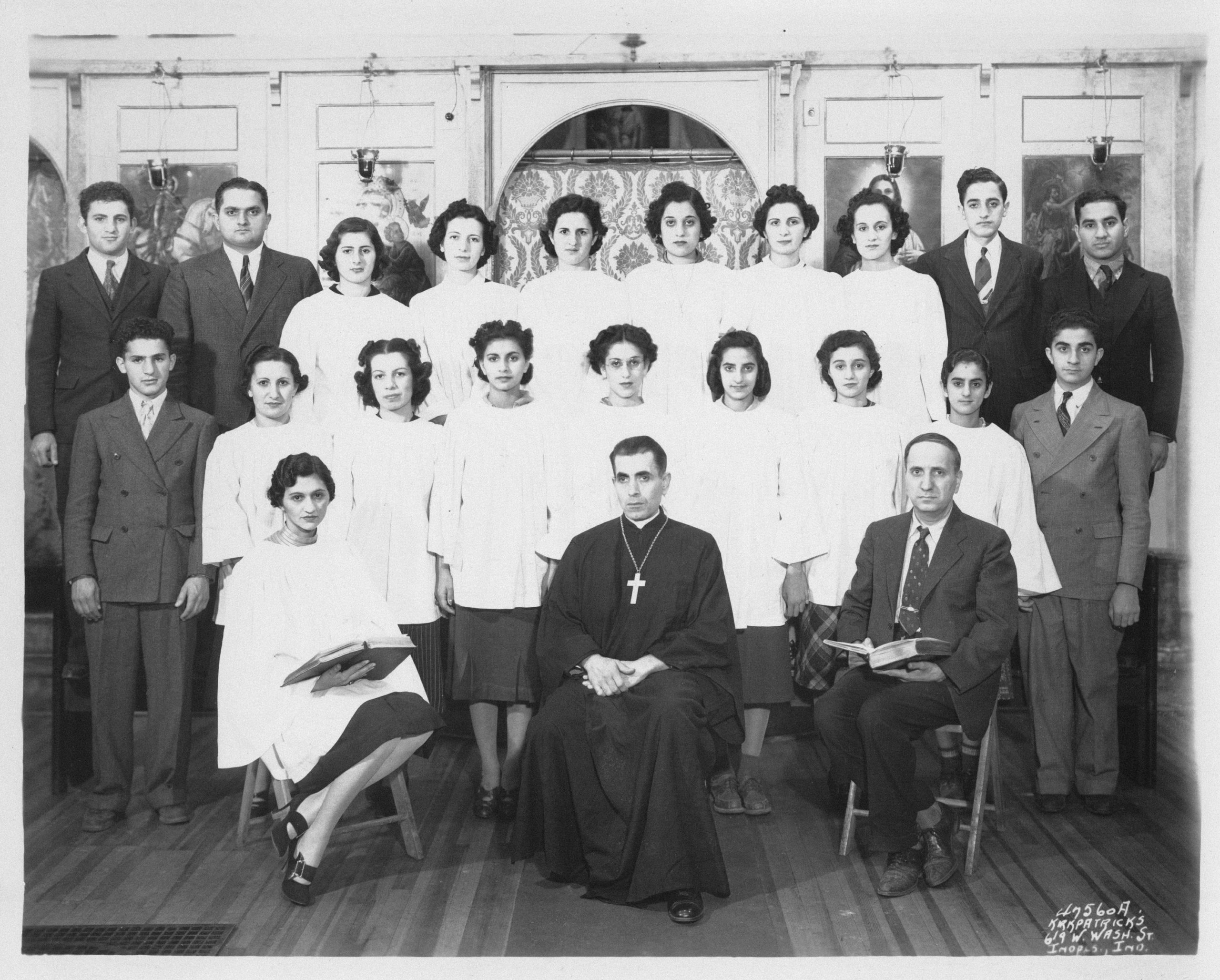
The new fellowship hall gave rise to the formation of yet another organization, a young people’s club, appropriately named the St. George Progressives. Abe Joseph was elected the first president of this group in 1934. This organization became a dynamic force in the social as well as spiritual activities of the church. In addition to regular social events and dances sponsored by the St. George Progressives, their basketball teams competed in community leagues and scheduled games with parishes in Terre Haute, Indiana; Toledo, Ohio; and Grand Rapids, Michigan. When the call went out for young people’s clubs in the Midwest to meet in Detroit, Michigan, the St. George Progressives were eager to participate. They sent a large delegation to Detroit on April 13, 1947, to help name and organize the Syrian Orthodox Youth Organizations (later renamed the Society of Orthodox Youth Organizations). As a charter member, the St. George Progressives went on to contribute greatly to the SOYO movement. St. George parishioners Nick Coba and John Daniluck, who had been founders of the Federation of Russian Orthodox Clubs (FROC), were instrumental in guiding the SOYO movement of their adopted parish and Archdiocese. In the fall of 1947, the newly organized group met in Indianapolis to complete a draft of the constitution and by-laws of SOYO and to set the time and date of the first annual convention to be held in Grand Rapids, Michigan, the following year. The Progressives have also hosted successful SOYO conventions in 1949, 1955, 1961 and 1972. At each convention many new ‘firsts’ were established, including the launching of a Teen SOYO. Seven members of the Indianapolis chapter, William Kafoure, Nicholas Coba, Alice Mesalam, Nicholas Ferris, George Freije, Janice Fadel and Vicki Mesalam have served as Presidents of Midwest and/or NAC SOYO, and many others have served on every SOYO committee and in every executive office. Two members of the parish, William Kafoure and Nicholas Coba, served as Editors of the SOYO Digest when the editorial office was moved from Toledo, Ohio, to Indianapolis.
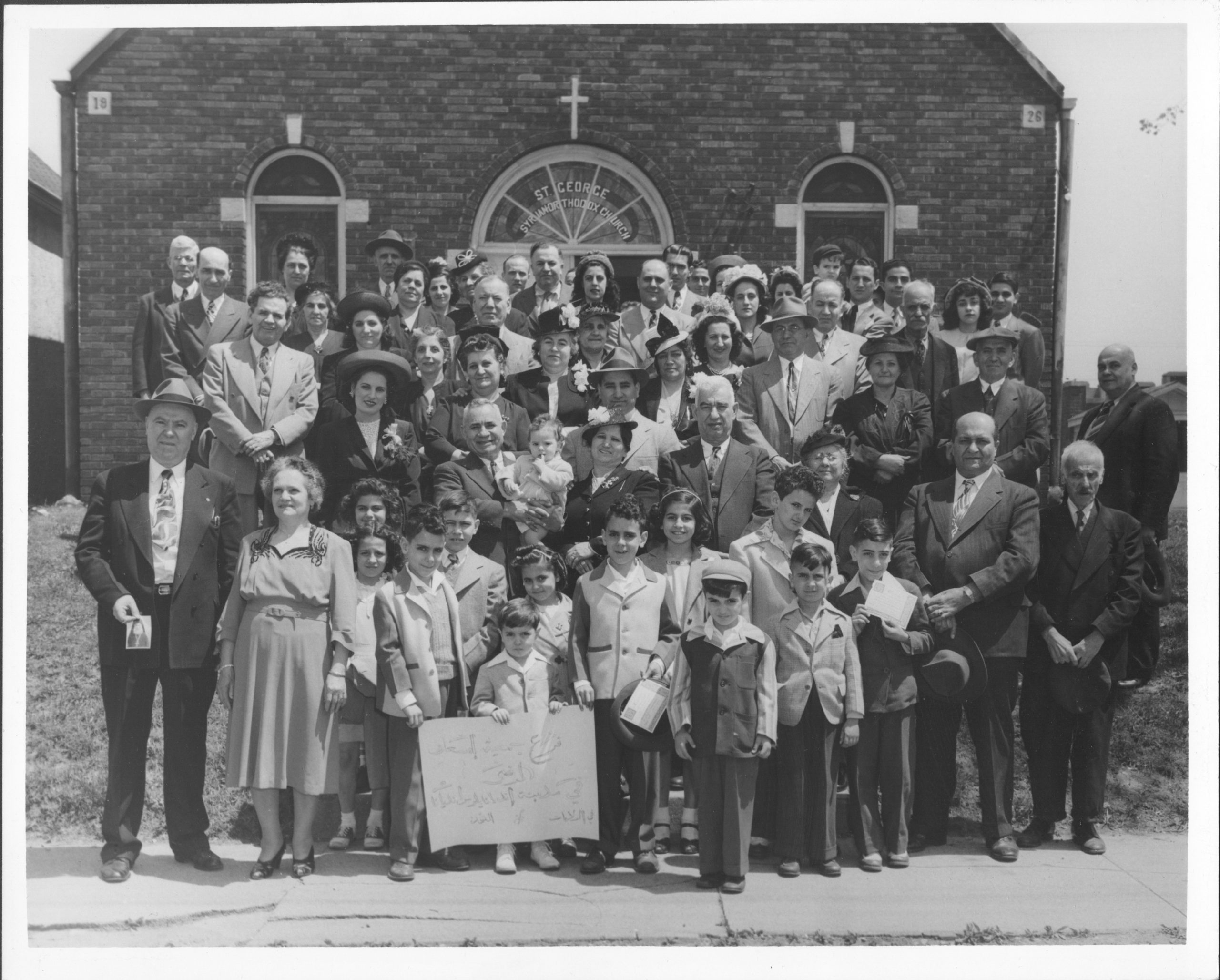
After World War II, the church’s administration was reorganized. A new constitution and set of by-laws were drafted by A.G. Corey and his committee, and these were adopted at a parish meeting. A board of trustees was elected as a representative administrative body of the parish. Once again a building fund was set up because a definite need for future expansion was foreseen. In 1949, the parish purchased a home on Princeton Place to serve as the parish rectory. The Indianapolis parish hosted an Archdiocese Convention in August, 1951. At that Convention, a young man named Michael Shaheen was ordained to the priesthood by both Archbishops Antony (Bashir) and Samuel (David) and assigned to the Indianapolis church. Father Michael was subsequently ordained as an Archbishop. In 1956, the Board of Trustees found a 21-acre tract of ground centrally located in the city and decided to make it the site for a new church. The St. George Progressives helped the parish with a generous contribution of $50,000 to purchase the property. On the grounds stood a lovely, two-story home which was to serve as the new parish rectory, a grove of trees for picnic grounds, a creek in the woods, and ample fields for a Little League baseball diamond. As a dynamic young priest, Fr. Joseph Shaheen oversaw in 1961 the start of construction for a new church and social hall. The edifice was completed the following year, and, on September 23, 1962, Metropolitan Antony officiated at the consecration and Hierarchical Divine Liturgy. The church is constructed of brick and Indiana limestone. Huge floor-to-ceiling stained glass windows depict the life of Christ and honor major saints of the Church. The stained-glass panels were designed by Ralph Craig of Indianapolis, who also painted the icons on the iconostasis.
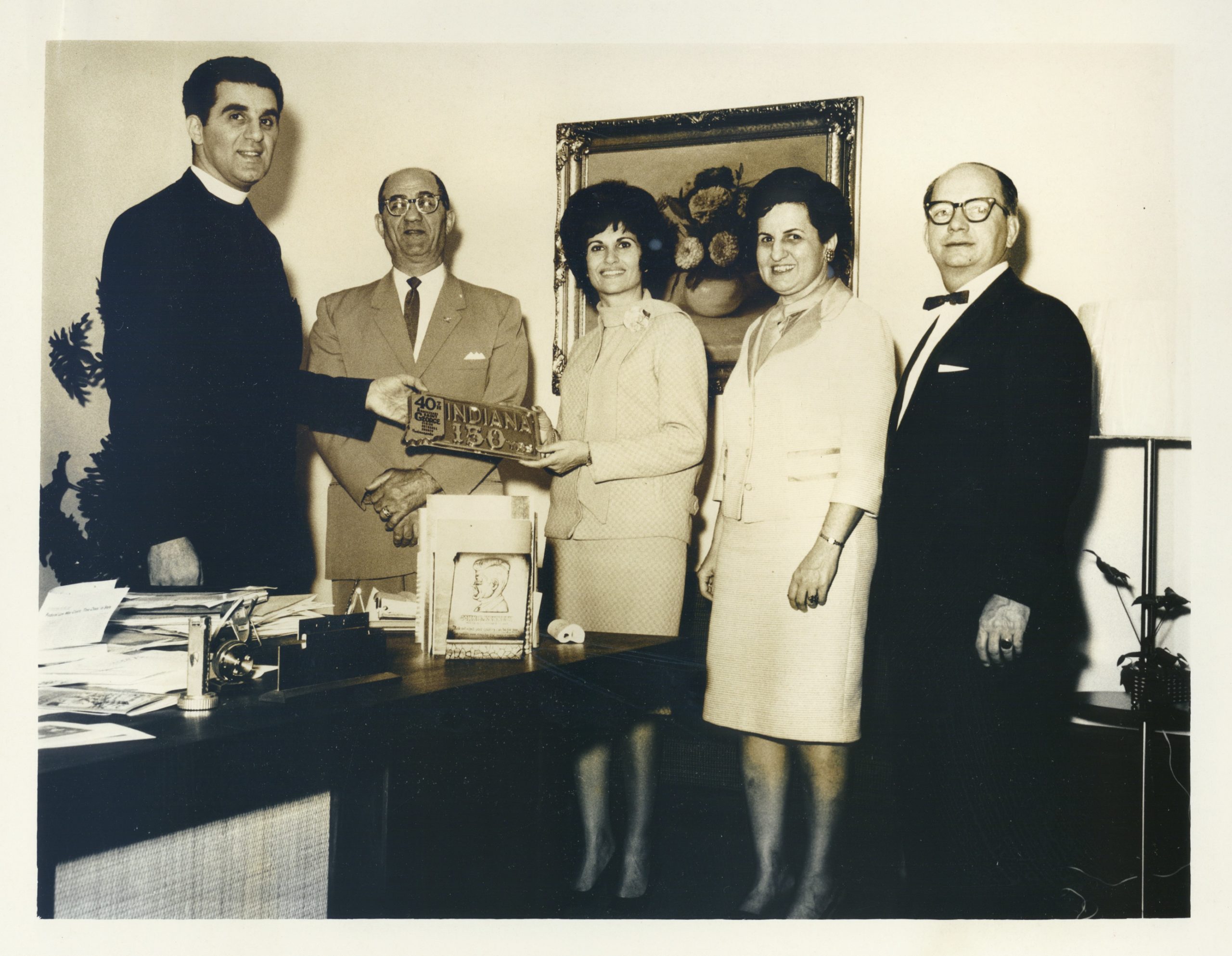
he parish was indeed proud of its accomplishments. Immediately, however, the parishioners went to work to pay off a mortgage they had assumed to build the new church and, on September 18, 1966, in conjunction with the 40th Anniversary celebration, they burned the mortgage. This had been accomplished in less than four years through ongoing fund-raising efforts headed up by John Daniluck. In 1976, the social hall was remodeled in time for the Golden Jubilee weekend that September. Under the pastorship of Fr. Joseph Rahal, the parish continued to expand. Many non-Arab Orthodox and many converts made St. George’s their home, and the parish gave birth to a mission in Fort Wayne, Indiana, in 1978 that eventually became St. John Chrysostom Church.
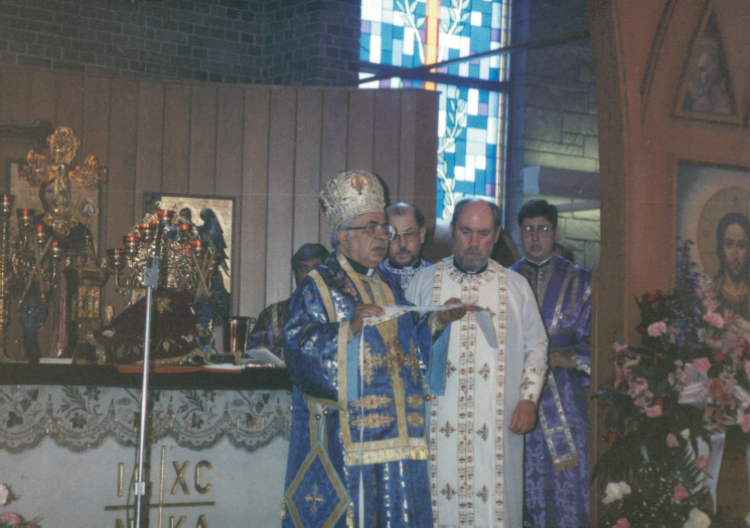
In 1985, Archie Wilson, a convert member of the parish, was ordained as a deacon by Metropolitan-Archbishop Philip, who also elevated then Pastor Father Joseph Olas to the dignity of Archpriest at the same time. Now known as Deacon Athanasius, Archie served at St. George until he was ordained to the priesthood by Bishop Antoun, in 1994, and became pastor of a new daughter mission in Bloomington, Indiana. That community grew quickly into a full-fledged parish, All Saints Orthodox Church. By 1987, having once again outgrown its facilities, St. George parish undertook to build an addition that included a conference room, lounge, Sunday School classrooms and improved kitchen facilities. 1992 was a banner year for St. George. His Grace Bishop Basil made his first visit to the parish in conjunction with the 60th Anniversary Celebration of the Ladies’ Aid Society. During his visit he tonsured young Joseph Olas, son of Father Joseph, as a sub-deacon. In preparation for these events the fellowship hall and foyer were completely redecorated in an elegant manner. While the early years of St. George’s history saw buildings going up, efforts gradually shifted toward greater ministry, service and the spiritual life. The process had begun with the formation of SOYO and accelerated in 1992 with the establishment of the Fellowship of St. John the Divine as its successor. The new organization was created to implement the concept, “Living the Orthodox Faith in Christ through worship, witness, service and fellowship.” The new Fellowship’s aims included the promotion of spiritual growth, humanitarian works, evangelism and missions through a variety of parish ministry teams matching members’ talents and interests with community needs.
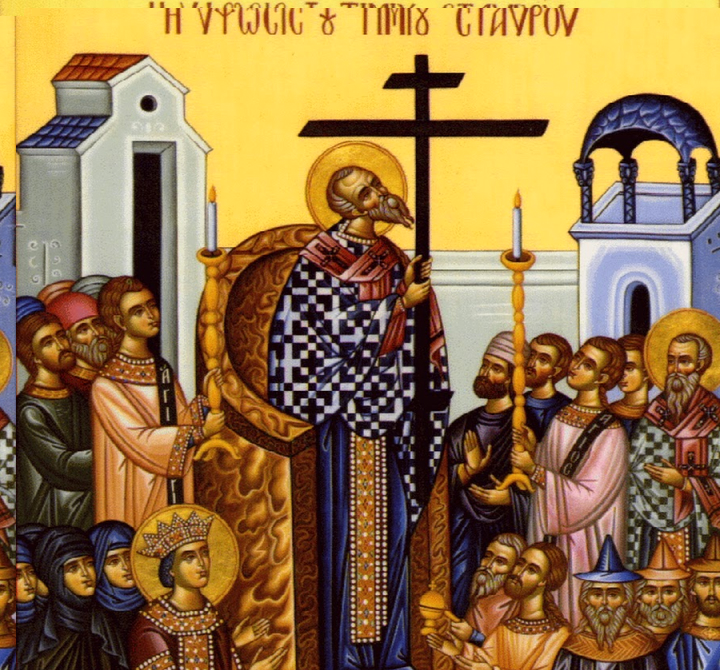
During the next several years, the church membership grew in a number of ways. The third and fourth generations since the founders had increased, resulting in the large number of young people active in our church. Secondly, there was a new influx of immigrants, primarily from Palestine, Jordan, Eritrea and Ethiopia. Also, many new members came into the fold from other Orthodox ethnic backgrounds, especially Russians. In addition, a number of converts from other Christian bodies accepted Orthodoxy. The diversity of the new membership has given the church a new complexion and drive. In 1995, the parish changed its long-running annual fund-raising event from a smorgasbord to the Middle Eastern Festival. Because of its success, the Festival has become an annual event. By 2001 the Festival had become a major avenue of bearing witness to the Orthodox Faith and the Middle Eastern heritage in the community, drawing around 4000 guests over two days, with about 800 taking advantage of church tours. A number of present parish members were introduced to the Faith through the church tours. Also in 1995, Father Joseph Olas retired due to ill health, continuing to reside in Indianapolis (until his departure from this life in 1997), and Metropolitan Philip appointed the Reverend Nabil Hanna as pastor, who arrived in time to guide the parish through the 70th Anniversary Celebration. In January of 1996, the parish welcomed our new auxiliary Bishop, His Grace Bishop Demetri, specifically assigned to care for the parishes of the Midwest Region. He met with each organization individually, celebrated a Hierarchical Divine Liturgy and attended a banquet with the entire parish to open the year-long 70th Anniversary celebration. Bishop Demetri returned that October for the climax of the 70th Anniversary celebration and has visited the parish on regular pastoral visits ever since. In the years since then, the parish has continued to grow at a rapid pace, and many programs were continued, and new programs were started. These include, Bible studies, an enquirers’ class, Young Married Couples fellowship, the charity ministry, a welcoming ministry (a team of people who serve as ushers and who help visitors, prospective members and new members integrate into the parish) and a pan-Orthodox cemetery. The Church School has grown to overflowing, with an average of over 100 students in attendance each week. The Ladies’ Aid Society initiated and gave seed funding for a self-perpetuating bookstore managed by Diane Koers and Beth Flaris. To support the many activities and to increase the professionalism with which they are conducted, a full-time church secretary was hired to assist the pastor.
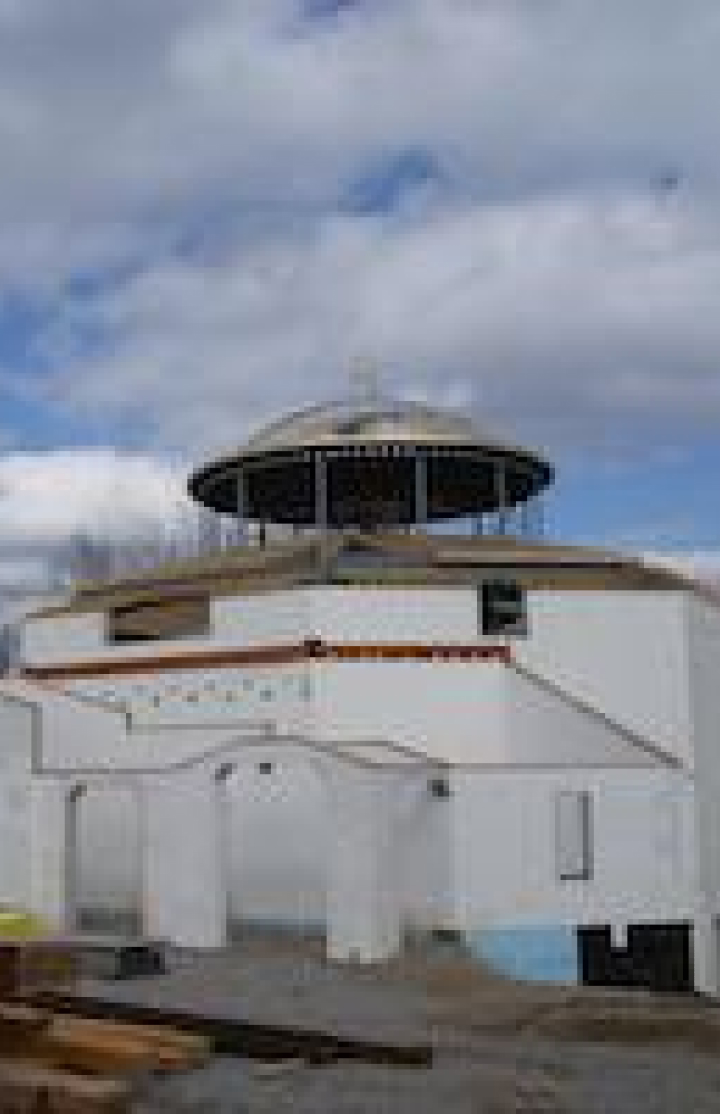
In 1998 a young man from Ethiopia who had studied at St. Tikhon’s Seminary and had moved to Indianapolis with his wife a few years earlier, became our deacon. Dn. Workineh Belesse immediately began to contribute greatly to the worship at St. George’s through his humble and dignified assistance at Divine services. The same year, the Ladies’ Aid Society formally adopted St. Thekla as their patron during a Midwest Region Delegates’ Meeting that St. George’s hosted in September, where Khouriyah Elaine Hanna gave the keynote speech on “Role Models for Girls Today.” The next year saw adoption of the Mother of the Shepherds Church and School in Beit Sahour, Palestine, as a sister parish, with moral and financial support. At the 1999 Archdiocese Convention in Chicago, St. George Teen SOYO President Jad Najjar won the Oratorical Festival after previously winning the Midwest Region Oratorical Festival. A cornerstone of our Teen ministry lay in utilizing the Archdiocese camping program at the Antiochian Village. The parish makes a major investment in this by paying half the tuition and providing the transportation to enable more young people to participate. The Teens also undertake many local community service and fellowship projects. Later that same year, the parish celebrated the elevation of Fr. Nabil Hanna to the dignity of Archpriest by Bishop Demetri. The parish and groups within the parish have gone on various outings to monasteries, museums, retreats, conferences, etc., including a visit to the Shrine of the Weeping Icon, Our Lady of Cicero (Illinois). Fr. Nabil and a delegation of 18 persons from the parish participated in the historic canonization of Bishop Raphael (Hawaweeny) May 27-28, 2000, at St. Tikhon’s Seminary and Monastery in Pennsylvania—the largest group from any one parish. The “2000th Year of Our Lord” saw a year-long series of events culminating in a pan-Orthodox Liturgy at the Indiana Roof Ballroom, with Fr. Thomas Hopko, Dean of St. Vladimir’s Seminary, as special guest speaker. Special icons were commission for this millennial occasion, including a Platytera (“More Spacious than the Heavens”) icon, an enlargement of which was placed in the apse of the church. The Lilly Endowment helped fund this effort of the Central Indiana Council of Orthodox Christian Churches to keep Christ in the ‘millennium’ celebrations, with the message for the public of central Indiana that He is the reason for the year 2000, when God became a creature for the sake of redeeming all creation. That year was also marked by the departure from this life of a parishioner of international renown, Charles Bozidar Ashanin, a theologian and Church historian. He had been a professor at Christian Theological Seminary in Indianapolis for many years, so the Seminary and the Orthodox Churches of Central established an annual, jointly-sponsored lecture in his honor. The close cooperation of area Orthodox parishes also led to the establishment of an Orthodox cemetery section and joint charitable work through the International Orthodox Christian Charities (IOCC).
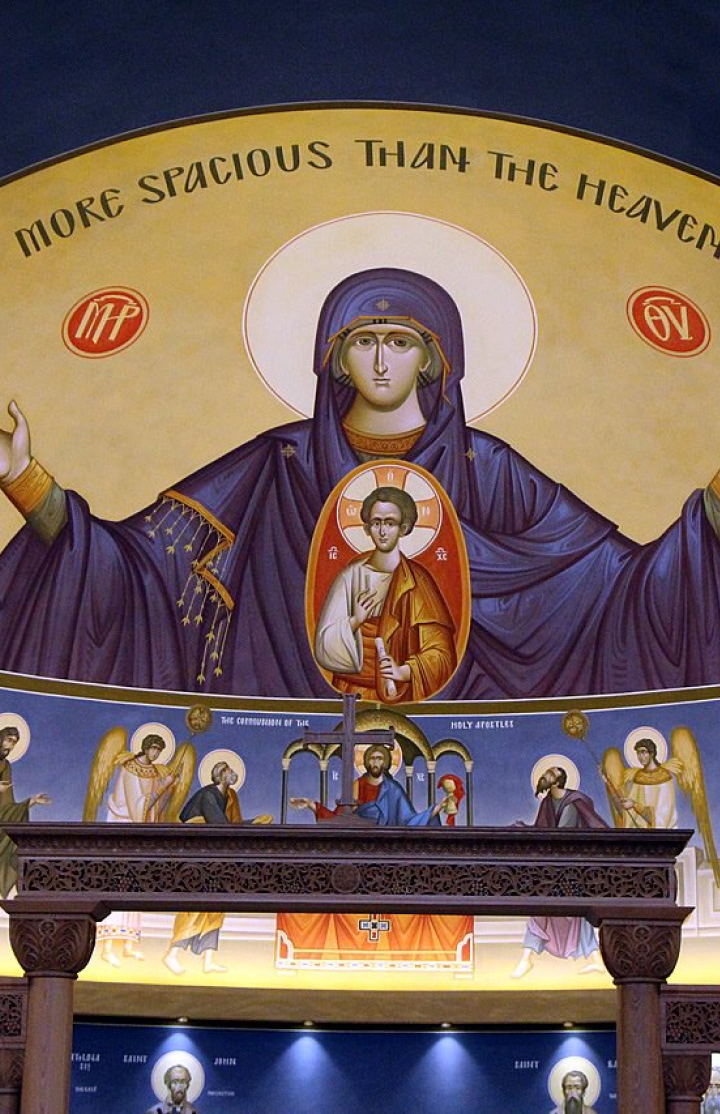
The year 2001 marked our 75th Anniversary, which Bishop Demetri inaugurated January 19-21. That special year saw installation of a granite floor for the solea of the church, an enclosed area for the bookstore, a new roof and expansion of the parking lot. A new Library and Archives ministry team, coordinated by Rick Gann, played a vital role in the 75th anniversary celebration. They went through the many boxes of stored items at church and collected many photographs, publications and other parish memorabilia that parishioners had in their homes. These items were copied, scanned digitally to preserve them and included in a time capsule that was placed in the cornerstone of the church at the opening of the 75th Anniversary Weekend, November 9-11. Parishioners—including children—wrote notes to future parishioners, expressing their hopes and dreams for them. The time capsule is to be opened by those future parishioners at the 100th Anniversary. Interviews with a cross-section of parishioners—particularly Zemurod Corey, the last surviving founder, and other senior members—yielded a rich testimony to St. George’s heritage. A collage of the interviews and photos was incorporated into a video produced and directed by Lisa Sophia Thomas and presented at the 75th Anniversary Grand Banquet, and copies were made available to parishioners. The Anniversary itself was a “Reunion Weekend,” when parishioners who had moved away and former pastors were invited to come back ‘home.’ Father Basil and Loretta Karpelenia (served here from 1958-60) and Father Joseph Rahal (served here from 1973-81), along with His Grace, Bishop Demetri, were special guests of honor. A musical production, written and directed by Choir Director Sharon Mustaklem, giving the history of the immigrants, the formation of the parish and events in the life of this community was told through the eyes of our departed former pastors and of departed parishioners Zemurod Corey and Alice Mesalam. Along with the time-capsule ceremony, this representation of our history was offered as a part of the city-wide “Spirit and Place Festival” of the city’s cultural heritage. Tragically, however, our country was attacked on day that no one will forget: September 11 of our Anniversary year. On that day and for several days following, St. George’s held special prayer services and participated in city-wide prayer events, invoking God’s help for our nation, for the victims of the World Trade Center and Pentagon and for all those affected by these devastating events. Our parishioners gave very generously to relief efforts through the IOCC and the Archdiocese, and the victims were remembered in special prayers and hymns during the Anniversary celebration, with Fr. Basil Karpelenia leading the parish in a rousing chorus of “God Bless America.”
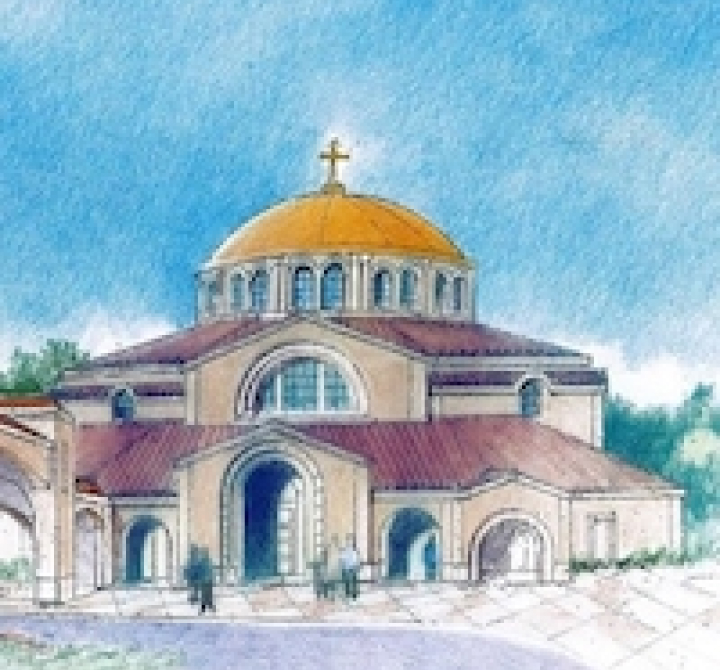
As St. George parish looks forward to a bright future, we are looking for land and evaluating options for the challenge of ministering effectively to a growing number of parishioners in an ever-expanding metropolitan area. St. George is proud of its heritage, organizations and their accomplishments. Its steady growth and development are the result of a high-spirited and dedicated membership working devotedly with the following Reverend Fathers who have served faithfully as pastors over the years:
Prepared by Bill Kafoure
for the 70th Anniversary Celebration, October 1996
Updated by Bill Kafoure and the Library and Archives Ministry Team for the 75th Anniversary Celebration, November 2001
- John Corey
- Nasib Wahby
- Gabriel Salhany
- Ignatius Preston
- Elias Hage
- Basilos Seidaoui
- Elias Dacy
- Louis Secabe
- Michael Shaheen
- Victor George
- Anthony Sakey
- Benjamin Hoffiz
- Basilious Mahfouz
- Nicholas Vansuch
- John Koury
- Basil Karpelina
- Joseph Shaheen
- Theodore Ziton
- Joseph Rahal
- Antony Beauchamp
- Joseph Olas
- Nabil Hanna
† indicates departed this life

